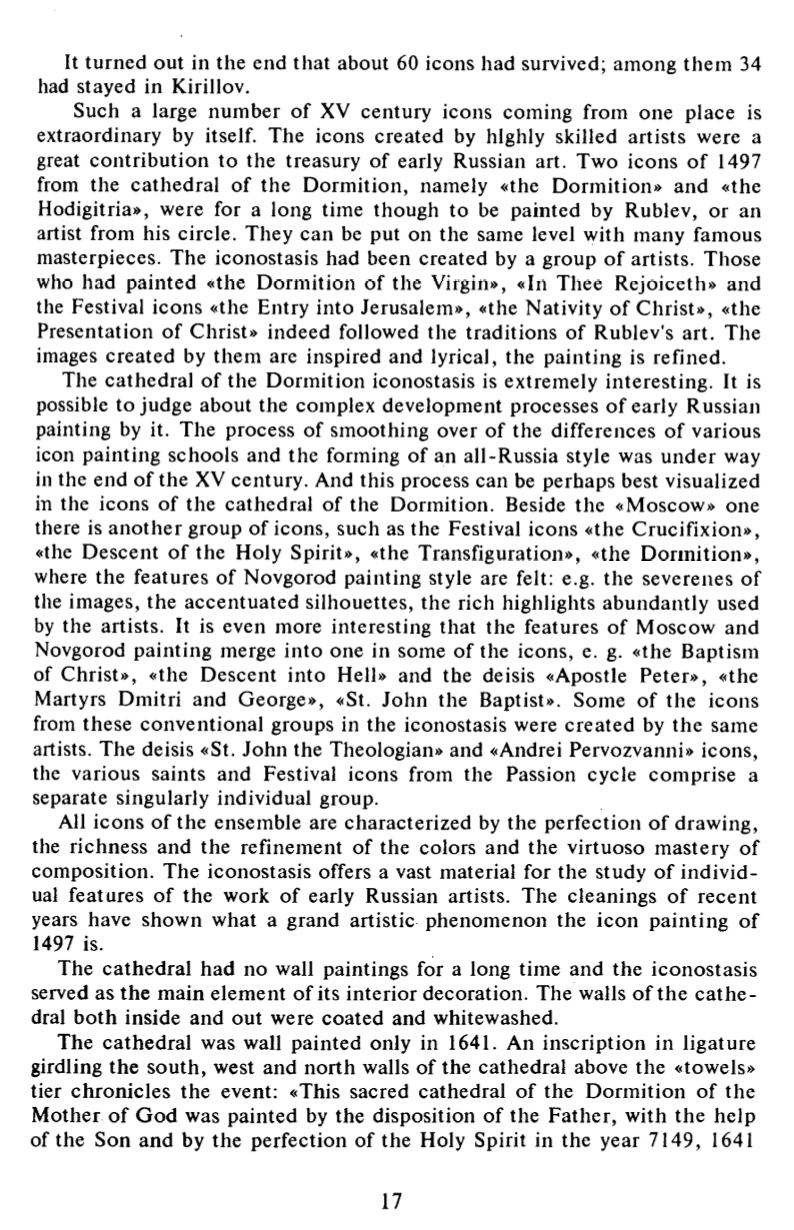

It turned out in the end that about 60 icons had survived; among them 34
had stayed in Kirillov.
Such a large number o f XV century icons coming from one place is
extraordinary by itself. The icons created by highly skilled artists were a
great con tribu tion to the treasury of early Russian art. Two icons o f 1497
from the cathedral o f the Dormition, namely «the Dormition» and «the
Hodigitria», were for a long time though to be painted by Rublev, or an
artist from his circle. They can be put on the same level with many famous
masterpieces. The iconostasis had been created by a group o f artists. Those
who had painted «the Dormition o f the Virgin», «In Thee Rejoiceth» and
the Festival icons «the Entry into Jerusalem», «the Nativity o f Christ», «the
Presentation o f Christ» indeed followed the traditions of Rublev's art. The
images created by them are inspired and lyrical, the painting is refined.
The cathedral o f the Dormition iconostasis is extremely interesting. It is
possible to judge about the complex development processes o f early Russian
painting by it. The process of smoothing over o f the differences o f various
icon painting schools and the forming o f an all-Russia style was unde r way
in the end o f the XV century. And this process can be perhaps best visualized
in the icons o f the cathedral of the Dormition. Beside the «Moscow» one
there is ano the r group of icons, such as the Festival icons «the Crucifixion»,
«the Descen t o f the Holy Spirit», «the Transfiguration», «the Dormition» ,
where the features of Novgorod painting style are felt: e.g. the severenes o f
the images, the accen tuated silhouettes, the rich highlights abundan tly used
by the artists. It is even more interesting that the features o f Moscow and
Novgorod painting merge in to one in some o f the icons, e. g. «the Baptism
of Christ», «the Descent into Hell» and the deisis «Apostle Peter», «the
Martyrs Dmitri and George», «St. John the Baptist». Some o f the icons
from these conventional groups in the iconostasis were created by the same
artists. The deisis «St. John the Theologian» and «Andrei Pervozvanni» icons,
the various saints and Festival icons from the Passion cycle comprise a
separate singularly individual group.
All icons o f the ensemble are characterized by the perfection o f drawing,
the richness and the refinement of the colors and the virtuoso mastery of
composition. The iconostasis offers a vast material for the study o f ind iv id
ual features o f the work o f early Russian artists. The cleanings o f recent
years have shown what a grand artistic phenomenon the icon pain ting o f
1497 is.
The ca thed ra l had no wall paintings for a long time and the iconostasis
served as the main element o f its interior decoration. The walls o f the c a th e
dral bo th inside and out were coated and whitewashed.
The cathedral was wall painted only in 1641. An inscription in ligature
girdling the sou th , west and no rth walls of the cathedral above the «towels»
tier ch ron icles the event: «This sacred cathedral o f the Do rm ition o f the
Mother o f G od was painted by the disposition o f the Father, with the help
of the Son and by the perfection of the Holy Spirit in the year 7149, 1641
17















